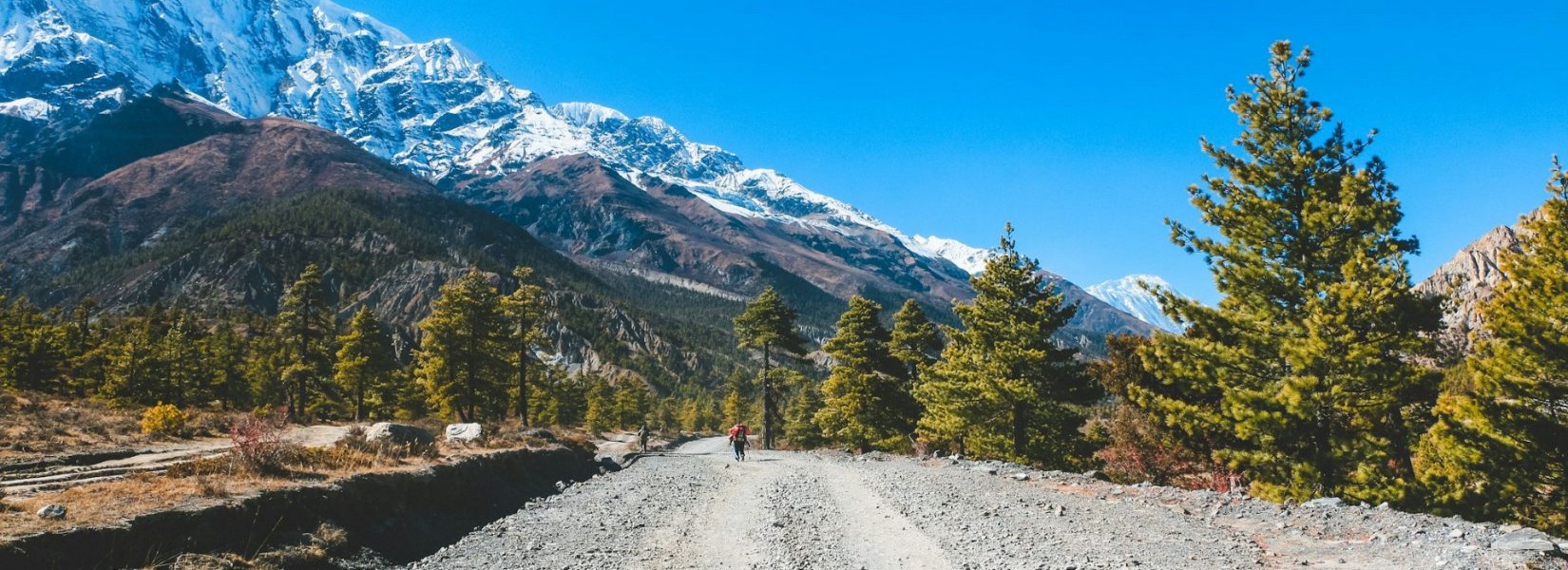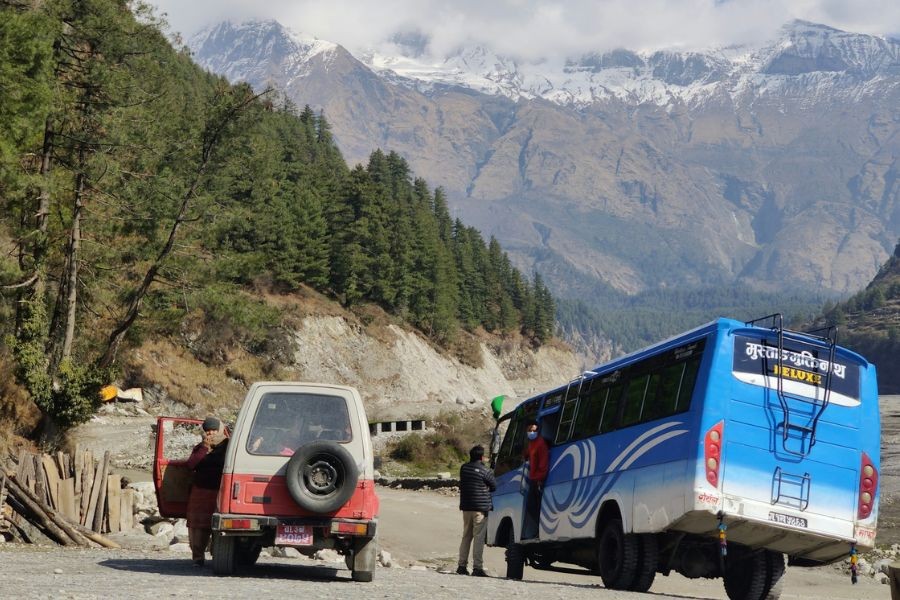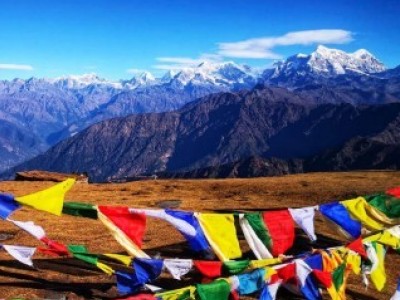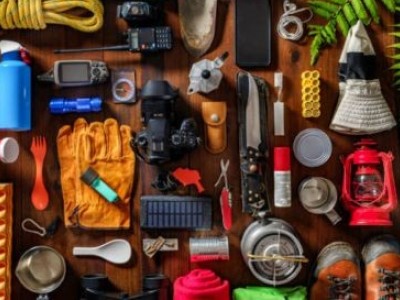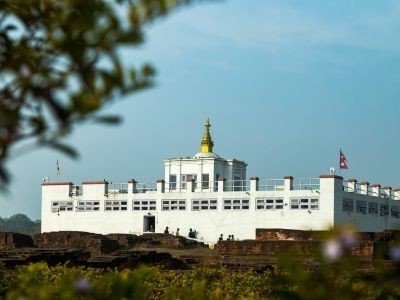Searching for the Annapurna Circuit trek cost? You've found the right place. Nestled in the northwest Himalayas of Nepal the Annapurna Circuit Trek is one of the most iconic best trekking routes in the Himalayas, offering an unforgettable journey through Nepal's diverse landscapes. From lush subtropical valleys and alpine meadows to the arid mountain deserts, this trek culminates at the exhilarating Thorong La Pass, soaring at 5,416 meters (17,769 feet).
But before tying your boots, one pressing question needs addressing: How much does it cost to trek to Annapurna Circuit?
Annapurna Circuit Trek Cost 2024/ 2025
While the experience is truly priceless, the cost of the journeyport can vary significantly depending on your preferences and choices. The cost of the Annapurna Circuit Trek largely depends on the trek's duration and the services you select. Depending on your pace and chosen itinerary, the Annapurna circuit takes 9 to 22 days to complete.
Generally, the Annapurna Circuit Trek Cost averages $800–$1,500, covering guides, porters, permits, transportation, meals, and accommodation. You have the freedom to customize your spending, enabling you to align costs with your preferences. Choosing budget-friendly options can reduce expenses, but investing in a guide and porter often enhances the overall trekking experience and safety.
Prices also vary between international and local agencies. Local agencies generally offer more affordable rates than international operators. Among local agencies, well-established companies with a strong reputation may charge higher fees compared to newer, less experienced firms.
With 30 years of expertise in the Himalayas, and a deep understanding of this iconic route we’ve explored every aspect of the Annapurna Circuit Trek to help you plan the memorable yet budget-friendly journey. This guide will break down the cost of Annapurna Circuit Trek in painstaking detail, covering everything from Nepal visas and travel insurance to meal expenses, guide/porter fees, and more.
Whether you’re a budget traveller, a mid-range adventurer, or seeking a luxury trekking experience, this blog will help you get enlightened on all the insights you need for Annapurna Circuit Trek Cost.
In this guide, we’ve outlined estimated costs for various trek-related expenses, such as meals and services in USD (1 USD = 134 Nepalese Rupee ) for a wider reach. Keep in mind that these prices are approximate and may vary due to exchange rate fluctuations, with the local currency being the Nepalese Rupee (Rs. or NPR).
Overall Annapurna Circuit Trek Cost Range
The cost of the Annapurna Circuit Trek can vary significantly based on the services selected, the trek's duration, and your travel preferences.
Budget-Friendy | $800–$1,200 |
Mid-range | $1,200–$2,000 |
Luxury options | $2,000–$3,500 |
This variability arises from factors like your choice of trek operator, level of services, personal spending habits and many more.
General Cost Factors for Annapurna Circuit Trek
- Operators: International or Local
- Trek Duration (9 to 22 days)
- Transfers to the Starting Point of Trek
- Accommodation in Cities: Kathmandu, Pokhara
- Accommodation during Trek
- Permits
- Guides
- Porters
- Meals on Route
- Showers
- Wifi on route (Free nowadays in ACT)
- Electricity Charging on route (Free nowadays in ACT)
- Transfer to Pokhara from Jomsom
- Transfer to Kathmandu
- Tips to guide and porter
- Personal Expenses
Breakdown of Annapurna Circuit Trek Costs
International Travel Expenses
Your journey begins with a flight to Nepal, which costs:
- From the USA or Europe: $1000–$1,500 (Round Trip)
- From Asia: $400–$700 (Round Trip)
Prices fluctuate based on booking time and season, so plan early for the best deals especially if travelling during peak trekking seasons (spring and autumn), when prices tend to soar. Book your tickets well in advance.
Nepal Visa Cost
Every foreign traveller needs a visa to enter Nepal, which is easily obtainable on arrival at Tribhuvan International Airport or online via the Department of Immigration. Here are the current fees:
Days | Cost |
15 Days | 30 USD |
30 Days | 50 USD |
90 Days | 125 USD |
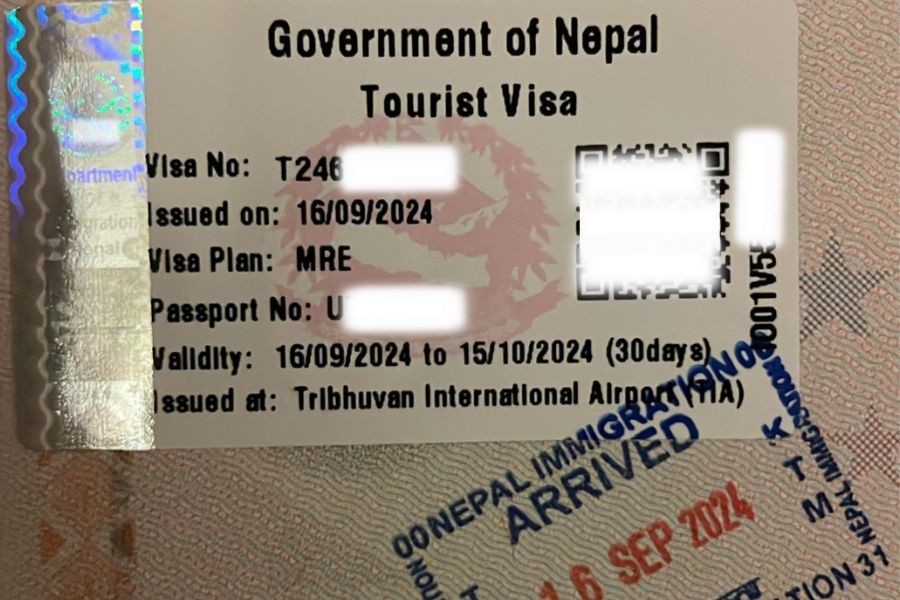
Ensure you have at least six months of validity on your passport and carry a few passport-sized photos for visa processing and permits. On-arrival visas are not available for Passport holders of some Nationals. For the latest Nepal Visa Fee and related information visit the Official Immigration Site. To apply for a Nepal Tourist Visa directly, visit the Electronic Travel Authorization website. Note: the application will only be valid for 15 days from submission.
Indian citizens can visit Nepal without needing a visa. To enter Nepal, you’ll just need a valid ID, such as your Election Commission card or passport.
Trekking Permits: ACAP and TIMS
As you’ll be trekking through the Annapurna Conservation Area, a region that the Nepalese government places significant emphasis on preserving and safeguarding, obtaining the required permits is essential.
The necessary permits are:
1. Annapurna Conservation Area Project Permit Cost (ACAP)
Foreigners | NPR 3,000 (~$23) |
SAARC nationals | NPR 200 (~$2) |
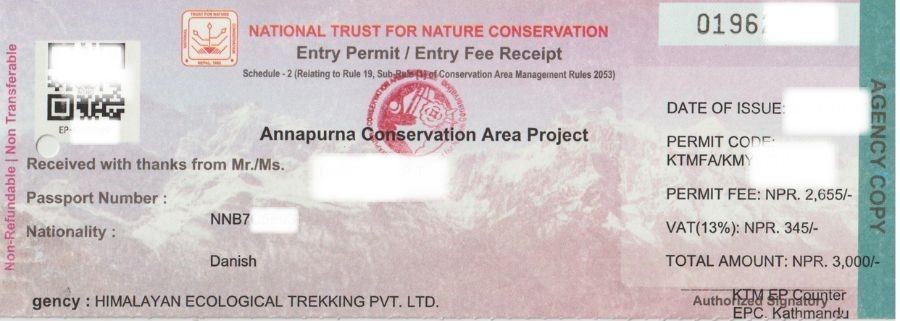
2. Trekker's Information Management System (TIMS) Card: (Not required Across Nepal As of now ~ 12th Dec 2024)
- Organized Trekkers: NPR 2,000 (~$15)
Permits can be arranged through trekking agencies like Himalayan Ecological Trekking or at the Nepal Tourism Board office in Kathmandu or Pokhara.
The Annapurna Area Conservation Area Permit (ACAP) was introduced in 1992 to help support conservation efforts and ensure sustainable tourism within this protected area. The permit helps fund conservation projects and local community development within the Annapurna region.
Transportation Costs
Transportation plays a crucial role in your Annapurna Circuit trek budget. The actual trekking for Annapurna Circuit trek starts at Besisahar or Syange and typically ends in Nayapul or Jomsom.
Transportation costs on the Annapurna Circuit Trek can be tailored to suit your budget. If you're looking to save money, local buses and microbuses are affordable options, with long-distance travel typically costing $8-$10 and short trips (Within Kathmandu and Pokhara City) ranging from $0.50-$1. However, being prepared for crowded conditions on local buses and securing a seat can be challenging, especially during peak times.
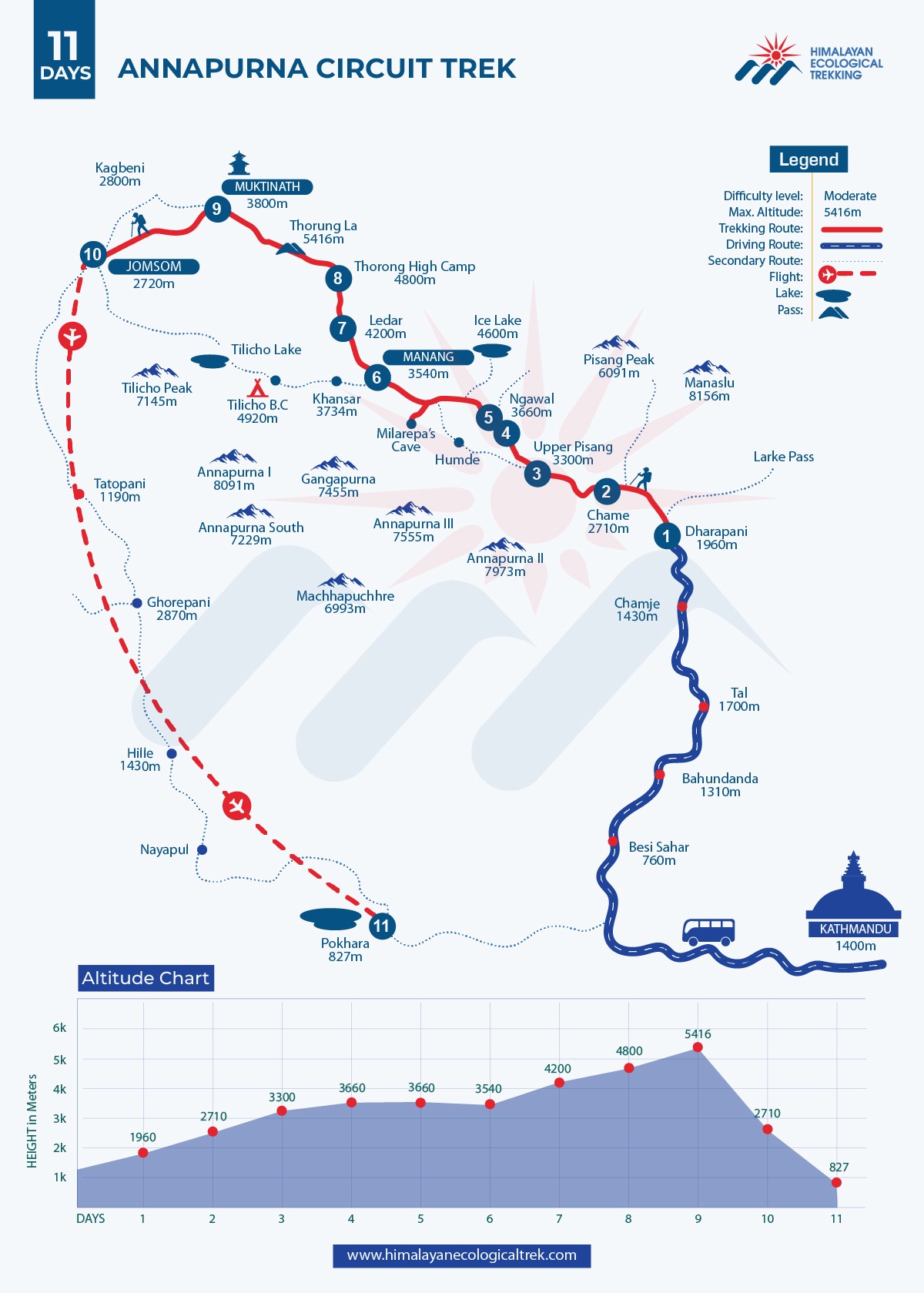
For those prioritizing comfort and convenience, domestic flights or private vehicles are excellent choices, albeit at a higher cost. Flights, offering a quicker and more comfortable journey, usually range from $50 to $100 one-way. Nepal has a robust network of domestic airlines that operate small STOL (Short Takeoff and Landing) aircraft, providing access to even the most remote destinations like Jomsom Airport and Manang (Manang airport, not in operation), which are among the farthest points served by air.
Cost for Reaching the Starting Point of Annapurna Circuit Trek:
- Kathmandu to Besisahar: Public bus: $8–$10.
- Besisahar to Jagat/ Dharapan/ Chame: $15/ $25/ $28 (Shared Local Jeep)
- Kathmandu to Syange or Dharapani (via private jeep): $250–$300, shared among 4–6 trekkers.
From | To | Transport Medium | Cost (USD) | Duration |
Kathmandu | Besisahar | Public Bus/ Microbus | $8 to $10 | 8-9 hrs |
Kathmandu | Syange/ Dharapani | Private Jeep | $250 to $300 (Shared among 4-6 trekkers) | 8-12 hrs |
Besisahar | Jagat | Shared Public Jeep | $15 (Rs. 2000) | 4 hrs |
Besisahar | Dharapani | Shared Public Jeep | $25 (Rs. 3000) | 5 hrs |
Besisahar | Chame | Shared Public Jeep | $28 (Rs. 3500) | 6-7 hrs |
Besisahar | Manang | Shared Public Jeep | $40 (Rs. 5000) | 9-10 hrs |
From the Ending Point:
- Muktinath to Pokhara o
- n public bus: $15
- Muktinath to Pokhara on Private Jeep: $210
- Nayapul to Pokhara: Taxi: $28, Local bus: $5–$10.
- Pokhara to Kathmandu on Tourist bus: $10–$25.
- Pokhara to Kathmandu on Flight: $106–$125 (20 minutes, with 25kg baggage allowance).
From | To | Transport Medium | Cost USD/ Npr (approx.) | Duration |
Muktinath | Jomsom | Public Bus | $3 (Rs. 300) | 1.5 to 2 hrs |
Muktinath | Jomsom | Jeep | $3-4 (Rs. 400) | 1.5 to 2 hrs |
Muktinath | Pokhara | Public Bus | $15 (Rs. 2,000) | 8-9 hrs |
Muktinath | Pokhara | Private Jeep | $210/ Rs. 28000 (Shared among trekkers upto 5 trekkers) | 8-9 hrs |
Pokhara | Kathmandu | Tourist Bus | $10-$25 | 7-8 hrs |
Pokhara | Kathmandu | Flight | $106-$125 | 20 min (25 kg baggage allowance) |
Guides and Porters
Hiring a guide or porter not only enhances your trek but also contributes to local livelihoods.
- Guide: $25–$35 per day
- Perks: Safety, navigation, cultural insights.
- Porter: $18–$25 per day
- Weight limit: 20–25kg; one porter can carry luggage for two trekkers.
- Porter-Guide: $25–$35 per day
- Combines basic guiding with luggage carrying. Normally Basic English.
- Language Specific Guide (Eg: German, Spanish, French): $45-$75 per day
While it’s possible to trek the Annapurna region independently, most trekkers opt to hire experienced guides or porters to navigate the numerous intersecting trails and unpredictable weather conditions. These professionals not only enhance your safety but also ensure a smoother, more enjoyable journey.
Why Hire a Guide?
Experienced guides are invaluable for several reasons. They help you navigate tricky routes, especially through areas with intersecting paths, dense fog, or snowfall, eliminating the risk of getting lost. Furthermore, guides act as translators, facilitating communication with locals, which allows you to gain deeper insights into the rich cultures and traditions of the region. This cultural exchange can significantly enrich your trekking experience.
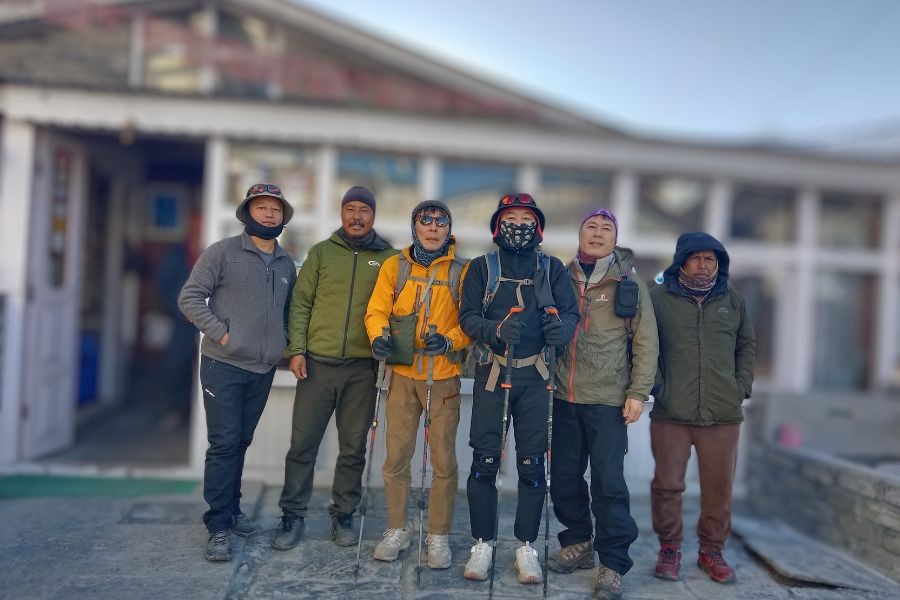
In case of emergencies, a guide can be life-saving. If you fall ill, suffer from altitude sickness, or face other medical issues, a knowledgeable guide can quickly assess the situation, provide first aid, and facilitate evacuation if necessary.
A good guide also monitors weather conditions and provides timely updates to ensure you’re trekking safely, especially in remote and potentially dangerous areas.
Guides usually charge $25-$35 per day, which covers their food, accommodation, and insurance. This cost reflects their expertise, which is crucial for a smooth and safe trekking experience.
Benefits of Hiring a Porter
Porters can greatly ease your journey by carrying 18-20 kg of your gear. One porter is hired for every two trekkers, with a maximum of 10 kg per person. This allows you to trek more comfortably and with less fatigue, especially on long and challenging stretches of the trail. With your heavy bags taken care of, you can focus entirely on enjoying the trek without the added physical strain.
Porters also typically cost around $18-$25 per day, including food, accommodation, and insurance. If you're trying to stay within a budget, hiring a porter can be a cost-effective way to enhance your trekking experience.
Some experienced porters even double as guides, which is an excellent way to reduce overall costs while still benefiting from the expertise and assistance of a professional.
Additionally, please note that the porter will also need to carry their bag. We kindly request you adhere to ethical practices, as porters are individuals deserving of respect and consideration. You may store any excess luggage securely at your hotel or with your Tour Operator's storage facility at no additional cost.
Combined Guide and Porter Services (Porter Guide)
Many trekkers prefer to hire a combined guide and porter service. With a combined service, you’ll have both professional navigation assistance and the physical support needed for carrying your gear. Porter-guides are highly experienced in trekking, familiar with routes and the profession, but usually have a basic command of English. They are very helpful in emergencies, ensuring that you have adequate help should you need evacuation or immediate medical attention. A porter guide is available only for groups of 1 or 2 travellers.
Key Perks of Hiring a Guide and Porter
- Safety & Navigation: Guides ensure you don’t get lost and help you navigate difficult or confusing sections of the trail, which is especially important in areas with poor visibility or weather disruptions.
- Cultural Insights: Having a guide allows you to engage with locals, learn about their way of life, and experience the culture of the Annapurna region more deeply.
- Reduced Fatigue: Porters lighten your load, allowing you to travel faster and with less exhaustion, making it easier to enjoy your trek. The guides and porters are also there to provide motivation and support, helping you continue your journey with confidence.
- Emergency Assistance: Both guides and porters are trained to deal with emergencies. If you encounter health issues or altitude sickness, they can act swiftly to help, ensuring your safety.
- Weather Monitoring: Guides track weather conditions to help you avoid dangerous weather situations, offering up-to-date advice on when it’s safe to continue trekking.
By hiring both a guide and a porter, you're investing in your comfort, safety, and overall trekking experience, ensuring a smoother, more enjoyable adventure through the Annapurna region.
Alternatively, you can pay your tour operator for the guide and permits, while covering your expenses for food, accommodation, and transportation on the spot yourself.
Many tour operators avoid providing insurance for guides and porters to reduce costs or increase profits. Please exercise caution when selecting an operator.
Hiring through reputable agencies like Himalayan Ecological Trekking ensures fair wages, insurance and ethical practices.
Annapurna circuit trek accommodation cost
Accommodation during Annapurna Circuit Trek is in teahouses, which offer basic rooms with twin-sharing beds. The costs for accommodation vary based on location and altitude. The higher you go, the higher the cost.
Be mindful that lodges along the trek rely heavily on meal sales for their income. If you choose to dine at a different lodge but stay overnight, the accommodation may cost you over $30 as compensation for the lost meal revenue.
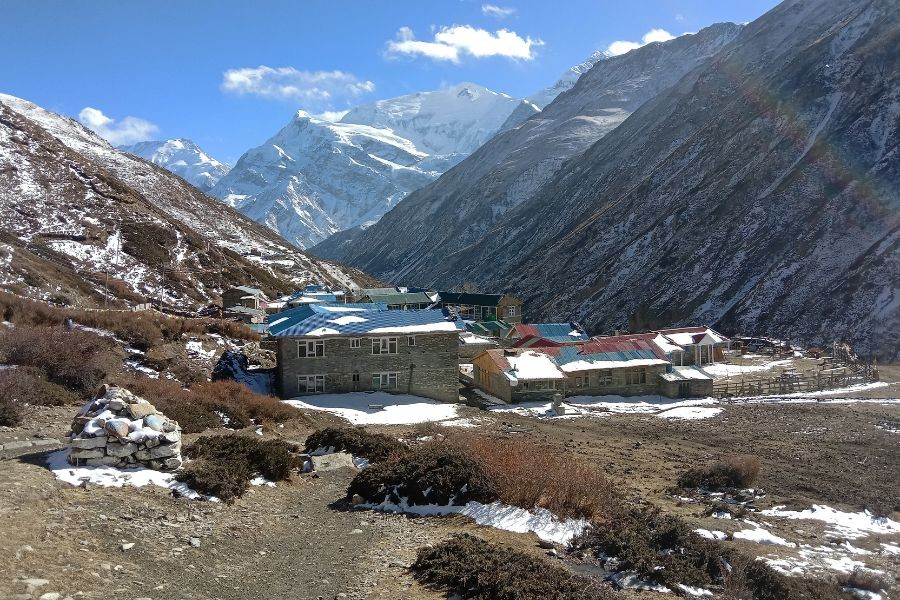
Some lodges provide upgraded accommodations, featuring private bathrooms, Wi-Fi, and hot water facilities for added comfort. These rooms usually range from $10 to $15 per night.
On the Trek:
- Basic tea houses: $5–$10 per night (twin-sharing).
- Premium lodges (lower altitudes): $20–$50.
Tour operators typically provide twin-shared beds for tea house accommodations, with an additional charge for private rooms.
However, private rooms may not always be available, particularly at higher altitudes such as Thorong Phedi or High Camp during peak seasons.
In Cities (Kathmandu and Pokhara):
- Budget hostels/ hotels: $5–$30 per night.
- Mid-range hotels: $50–$100.
- Luxury hotels: $150+
Some Recommended hotels in/ around Thamel, Kathmandu: Hotel Vistaraa and Hotel Vajra (3-star), Ramada Encore (4-star).
Food and Drink Costs During the Annapurna Circuit Trek
One of the highlights of the Annapurna Circuit Trek is experiencing the delicious local cuisine. At lower altitudes, you'll find a variety of options, including Nepali, Western, and Continental dishes.
However, as you ascend to higher elevations, the menu becomes simpler and more basic due to limited resources.
On the Trail: (per day)
- Breakfast: $4–$6
- Lunch: $5–$8
- Dinner: $6–$10
- Tea/Coffee: $1–$4 (Generally not included in Budget-friendly Tour Operated Package)
- Snacks and energy bars: $1–$5 per item
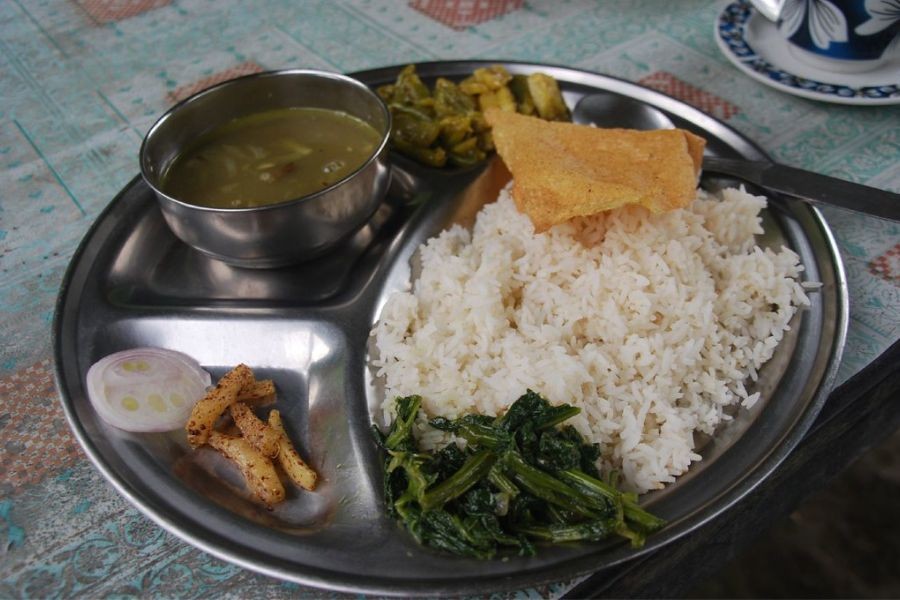
Breakfast
Starting your day with a hearty breakfast is essential to sustain your energy for the trek. A typical breakfast includes eggs, toast, potatoes, and a cup of coffee, costing around $6. Investing in a wholesome morning meal can help you avoid fatigue and keep you energized throughout the day.
You may crave hot tea in the cold mountains, if you are on a tour operator package check if it's included or excluded in the package provided by your tour operator.
Lunch
Lunch usually features a classic Nepali dish like dal bhat (rice, lentils, and curry), momos, and noodles, though you’ll also find lighter snacks or some Western options. A filling lunch costs between $6 and $7, but budget-conscious trekkers can opt for simpler meals. Dal Bhat is served in unlimited portions, but it is intended for individual servings.
Dinner
Dinner often includes lentil soup, rice, vegetables, and occasionally meat or pickles. At lower altitudes, dinner costs around $4, but prices increase to approximately $8 at higher elevations due to transportation challenges and limited supplies. It is recommended to have a soup, such as ginger garlic.
Snacks and Tea Breaks
Tea breaks along the trail are a welcome relief from the cold and fatigue. A cup of tea or coffee costs around $0.50 at lower altitudes and up to $2 in higher regions. These little luxuries can greatly enhance your trekking experience.
Key Tip
As you ascend, both the availability and variety of food decrease and prices increase. Be prepared for these changes and budget accordingly to ensure a satisfying and enjoyable trek.
Prices rise with altitude due to transportation challenges. Meals are hearty, often featuring local dishes like dal Bhat (lentil soup with rice)
Please note that most operators typically provide only one item for breakfast, lunch, and dinner. Some tour operated packages do not include tea or hot drinks, while others may offer tea or coffee only at breakfast, or up to three times a day. Be sure to carefully check the service inclusions and exclusions to see if hot water or beverages like tea or coffee are included.
Miscellaneous Costs
- Hot showers: $2–$5 per use.
- Wifi: $2–$5 per session. (Free as of now)
- Battery charging: $2–$5 per device. (Free as of now)
Unlike in Everest Base Camp Trek, and other treks where we need to pay extra for wifi and battery charging, most tea houses in Annapurna Circuit trek nowadays do not charge for Wifi and Battery Charging.
Travel Insurance
Comprehensive insurance covering high-altitude trekking and helicopter evacuation is crucial. Costs average $150 for 30 days. Ensure the policy includes:
- Emergency evacuation up to 6,000 meters.
- Medical coverage.
- Trip delays/cancellations.
Ensure you read the fineprint to confirm high-altitude trekking is included.
Travel insurance is essential when trekking in the Annapurna Circuit, particularly given its high-altitude conditions and potential risks like lost baggage, flight cancellations, medical emergencies, and trip interruptions.
Many standard policies don’t cover elevations above 4,000 meters, so it’s crucial to verify that your insurance covers you at higher altitudes. If you plan to do peak climbing as part of your trek, you'll also need mountaineering insurance.
Depending on your insurance provider, a comprehensive travel insurance policy typically costs around $150 for 30 days and should include coverage for emergency evacuation (up to 6,000 meters), medical expenses, and trip delays or cancellations. Always review the fine print to ensure that high-altitude trekking and helicopter evacuation are covered. Prices may vary between providers, so select the policy that best suits your needs and provides peace of mind throughout your trek. Ensure you provide a copy of your insurance to your tour operator for emergency purposes, as it is a required document for emergency helicopter evacuation.
Equipment Cost
The Annapurna Circuit Trek is considered a moderate trek and requires only basic equipment, making it accessible for most trekkers. You can either purchase or rent the necessary gear (Sleeping Bags and Down Jackets), with renting being a more budget-friendly option for those looking to minimize costs. Essential items for the trek include:
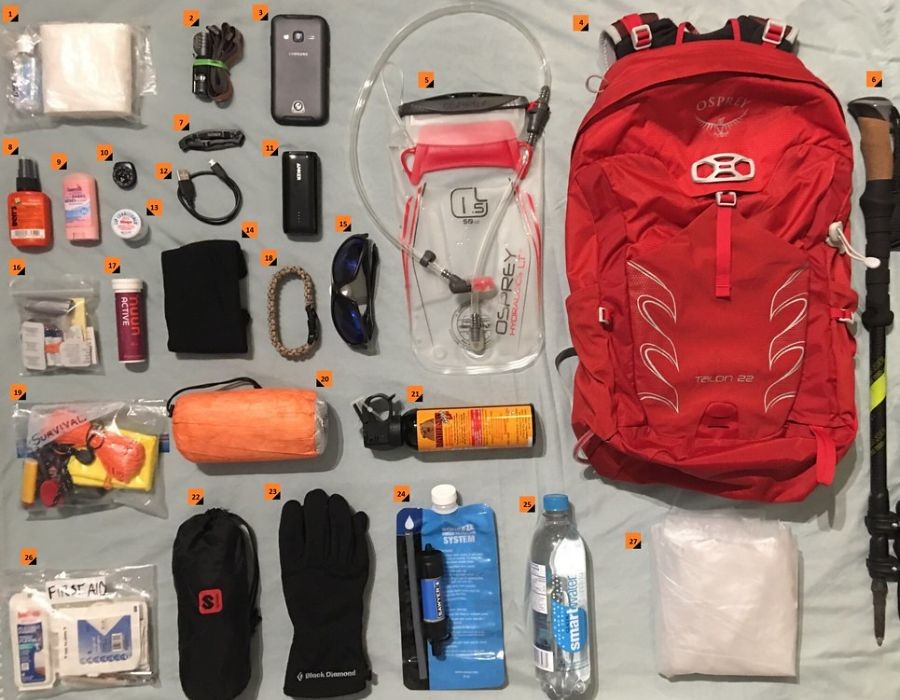
- Warm Sleeping Bag: Essential for cold nights, especially at higher altitudes. Rentals typically cost $1–$2/day, while buying one can range from $50 to $200. You can rent gear from trusted local shops in Thamel, and Kathmandu, or seek assistance from your tour operator. However, the temperature ratings of sleeping bags may not always be accurate, and sometimes you may require additional layers.
- Thermal Jacket and Trousers: These are crucial for staying warm in cold weather.
- Down Jacket: Purchasing a quality down jacket can range from $100 to $300.Rent $1 per day.
- Hiking Boots: A good pair of sturdy, comfortable hiking boots is essential for tackling the rough and uneven terrain of the Annapurna Circuit.
- Lightweight Backpack: A comfortable, durable backpack is necessary to carry your essentials during the trek.
- Hiking Poles (Optional): Helpful for stability and reducing strain on your knees, especially during descents.
- UV Sunglasses & Sunscreen: Protect your eyes and skin from the harsh sun, particularly at higher altitudes.
- Waterproof Bags: Important for keeping your gear dry in case of rain.
- Physical Annapurna Circuit Trek Map by Nepal Map House which can be bought at Thamel
Additional items like thermal wear, energy bars, or other personal preferences can also be added to your gear list. The total estimated cost for these essential items ranges from $500 to $1,000, depending on whether you rent or purchase the equipment.
By renting, you can significantly lower your initial costs, but for long-term trekkers, purchasing high-quality branded gear might be a better investment. Ensure you bring what you need for comfort, warmth, and protection to make your Annapurna Circuit experience more enjoyable and safe.
Other Costs and Additional Considerations
Tipping
Tipping is customary in Nepal, particularly for guides and porters. If you are satisfied with their service, a tip is a great way to show appreciation for their hard work and dedication.
As a general guideline, it’s common to tip around 10% of your total trekking cost, but the amount can vary based on your level of satisfaction.
For guides, the typical tip is between $150 – $200 for the entire trek, while porters usually receive $80 – $100. If you prefer a daily rate, you can tip $10+ per day for a guide and $8+ per day for a porter. Keep in mind, that if you feel the service was less than satisfactory, tipping is entirely optional, and you are not obligated to follow the standard guidelines.
Extra Nights:
Unforeseen circumstances like altitude sickness, weather and flight delays may require additional lodging ($5–$30/night).
Horse Riding
Horse riding is usually reserved for emergencies or when crossing Thorong La, and is not recommended for regular use. The cost for horse riding ranges from $100 to $150 per day, and the owner typically only accepts cash payments. It’s best to rely on trekking, and we do not recommend the use of animals. Animals can face difficult conditions in high-altitude areas.
Additional Tips
Currency Exchange:
For better exchange rates, use licensed money exchangers instead of hotels. Rates at money exchangers are typically more favourable. Alternatively, you can also exchange for Nepali rupees through your tour operator for more competitive rates.
Trip Extension
Consider budgeting for extending your trip to explore Chitwan, Bandipur or Pokhara
Power Banks and Solar Charger
Carrying a power bank or solar charger during the Annapurna Circuit trek is highly recommended, as electricity can be limited and charging devices at tea houses often comes with a fee ($1–$5 per charge). A power bank with a capacity of 10,000–20,000 mAh is perfect for keeping your devices charged for multiple days. Solar chargers are an eco-friendly alternative, especially on clear days in higher altitudes. Both options ensure you have access to essentials like maps, communication, and cameras without worrying about power availability.
Cost of SIM Card and Data
Getting a Nepali SIM card is a practical and cost-effective option for staying connected during the Annapurna Circuit trek, especially if you're trekking independently. It ensures communication during emergencies and helps avoid lodge Wi-Fi fees (typically $2–$5/hour). Nepal Telecom (NTC) offers the best coverage, even in remote areas like Manang and Thorong La, while NCELL works well at lower altitudes. SIM cards cost $5 to $8 at Kathmandu Airport while you can get them at a lesser cost around Thamel and Kathmandu City. Data packages range from $3–$10 for 3–10 GB. The Unlimited 1-month data plan cost of NTC ranges from $4.50 to $12, depending on the data package and additional features like voice calls and SMS. Purchase your SIM in Kathmandu or Pokhara for better deals. Note that many teahouses now provide free electricity and Wi-Fi, reducing the need for data in certain areas.
Airport Transfers
Local Taxis:
- Cost: Around $8–$15 (within Kathmandu city).
- Convenient and widely available, but make sure to negotiate the fare or use a taxi with a meter.
Hotel Shuttle Services:
- Cost: Free to $15 (depending on the hotel).
- Many mid-range and luxury hotels offer complimentary airport pickup and drop-off services.
Private Transfers (Tour Operators):
- Cost: $10–$15 per vehicle (one way).
- Suitable for hassle-free transport with professional drivers. Ideal for groups or those travelling with large luggage.
Ride-Hailing Apps (e.g., Pathao, InDrive):
Not recommended although this option is feasible, affordable and convenient, costing around $5–$8. However, it’s best suited for those familiar with Nepal’s transport system. Vehicle number plates are in Nepali, and drivers may not speak English, making it less ideal for first-time visitors. Reliable internet access is required to book. Most drivers mostly call customers in Nepali Sim Card which you’ll need to have obtained at the Airport.
Be cautious: Occasionally, tourists are scammed at the airport by unauthorized agents who offer to carry your baggage without consent and then demand a tip. To avoid this, pre-arrange your transfers with a trusted tour operator.
Types of Tour Operators
Tour operators play a crucial role in ensuring a seamless, safe, and enjoyable trekking experience, especially in the challenging terrains of the Himalayas. By entrusting your trek to a tour operator, you can avoid the stress of obtaining permits, navigating unfamiliar trails, or worrying about personal safety. Instead, you’ll benefit from the expertise of experienced guides and porters, who handle logistics, provide local insights, and ensure your journey is as smooth and effortless as possible.
There are two primary options when choosing a tour operator: local agencies and international (Western) agencies.
Western Tour Operators
- Pros: International agencies often provide comprehensive support, including pre-trip planning, International Flight Tickets, high-end gear, and detailed itineraries. Their guides are usually fluent in multiple languages and may cater to additional comforts or specific requirements.
- Cons: These agencies are significantly more expensive, with costs ranging from $2000 to $4,000 or more. The higher price point often reflects their administrative overheads and added luxuries rather than better trekking experiences.
- Pros: International agencies often provide comprehensive support, including pre-trip planning, International Flight Tickets, high-end gear, and detailed itineraries. Their guides are usually fluent in multiple languages and may cater to additional comforts or specific requirements.
Local Tour Operators
- Pros: Local agencies typically offer affordable pricing, in-depth knowledge of the region, and a more authentic experience. They are well-versed in the culture, language, and traditions of Nepal, adding an immersive element to your trek. Additionally, their guides and porters are accustomed to the local terrain and weather conditions, ensuring your safety.
- Costs: Hiring a local agency generally costs between $800 and $2000, depending on the duration of the trek, the level of service, and the inclusions.
Key Considerations
- Cost Efficiency: Local operators are generally the more cost-effective choice, providing similar or better on-the-ground services at a fraction of the price.
- Reputation: Whether choosing local or international, prioritize operators with excellent reviews and a proven track record for safety and service quality.
- Personalized Services: Some local operators, such as Himalayan Ecological Trekking, excel in tailoring treks to individual needs, offering options for small groups or solo travellers, secure storage for excess baggage, and flexible itineraries.
- Cultural Immersion: Local agencies often provide deeper cultural insights, enhancing the overall experience with stories, folklore, and local cuisine recommendations.
Why Choose a Tour Operator?
- Permit Handling: They take care of all required permits, such as ACAP and TIMS (not required now through Nepal), saving you the hassle of navigating bureaucracy.
- Guided Expertise: Guides bring invaluable knowledge of the trails, weather, and altitude safety, ensuring a worry-free trek.
- Porter Services: Hiring a porter eases the physical burden, allowing you to enjoy the trek without being weighed down by heavy luggage.
- Emergency Support: Operators are well-equipped to handle emergencies, including altitude sickness, injuries, or sudden changes in the weather, and can arrange for rescue or evacuation if needed.
- Streamlined Logistics: From transportation to accommodation bookings, everything is arranged for you, ensuring a seamless experience.
By choosing the right tour operator, you not only enhance your trekking experience but also gain peace of mind, knowing that every detail is professionally managed.
Need Help Planning Your Trip?
With 3 decades of experience, Himalayan Ecological Trekking offers seamless planning, ethical practices, and unmatched support to make your Annapurna Circuit Trek unforgettable. Whether you’re a budget traveller or seeking a luxurious experience, every dollar you spend will contribute to unforgettable memories. We’re available for online briefings (WhatsApp +977 9851006023 - Bikesh) to discuss everything related to your trek and help you choose the right one for you. For personalized packages and expert guidance, don’t hesitate to reach out to Himalayan Ecological Trekking!
